This is what happened.
I received an invitation to a talk at a gallery. Like many of you, I receive mass invitations for these things all the time. But this was different: it was going to be an “intimate” evening, and the speakers would be none other than Ed Ruscha and James Rosenquist, along with the artist, a painter named Theo Wujcik. Wujcik had shown previously at Galleri Urbane in Dallas, but I was only vaguely familiar with his work. The title of his show was Blue Chip. Hm.
Normally I would never travel to another city for a gallery talk. But: Ruscha! Rosenquist! I had met both artists about a decade prior, at a party in honor of Walter Hopps at the Menil Collection. I was eager to have the opportunity to meet them again.
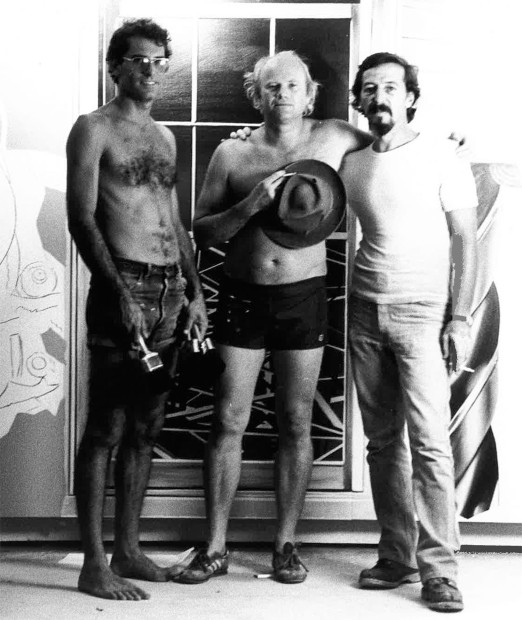
I figured the A-list Dallas art people would be there, because, you know: Ruscha! Rosenquist! When I drove up to the gallery, there were maybe eight cars in the dark street outside. There was no valet. It dawned on me that I might be overdressed. Inside, there was no sign of any museum directors or collectors with their own quasi-museums. These appeared to be nice, normal people. Friends of the gallery.
The show was a series of large paintings, each either a portrait of a famous artist or an homage to his style. The name of the subject was painted in block letters across the canvas. Both Rosenquist and Ruscha were represented, along with Hirst, Warhol, Koons and others. Stylistically, they referenced both Ruscha and Rosenquist. They were—it must be said—not very good. There’s not much to like with art about art, and even less with art about the art world. And really: do we need more starfucking? Whoever this Wujcik guy was, I just hoped he was more interesting than his paintings. All I knew was that he’s the same generation as Ruscha and Rosenquist, and has been a mainstay of the Tampa, Florida art scene for many years.
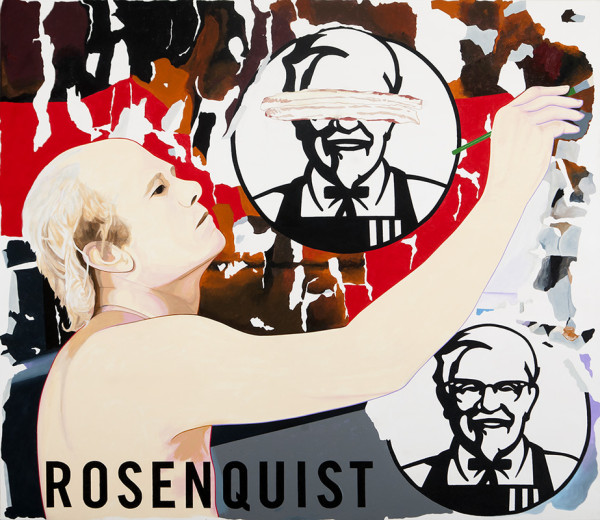
The audience was asked to take our seats. Ruscha and Rosenquist sat at a small table at one end of a room that’s roughly 30 feet square. I had to agree with the billing: this was certainly intimate. They both looked a little stunned.
It was at this point that I noticed a computer monitor on a pedestal, and realized there wasn’t a third chair at the table for Theo Wujcik. The gallery director Ree Willaford stood up and, clearly moved, announced that the artist himself was not in attendance, but would be Skyping in from his hospital bed in Tampa, where he was being treated for cancer. With dawning apprehension I realized the reason for Ruscha and Rosenquist’s stunned expressions– they had traveled in for their old friend, lending their illustrious names to his little show of un-great paintings in Dallas, and he wasn’t even there, because he was seriously ill, too sick to travel. And now they must see this grim thing through.
I imagined the same realization rippling through the crowd. But—the show went on, because it must. We were all going to stay positive and put the best face on things. The Skype video was connected, and the artist Theo Wujcik appeared on the monitor, filling the screen. He was on a bed in a hospital gown and he looked frail.

After a long and tedious introduction by a curator/moderator, which was meant to clarify Wujcik’s importance but which only made everyone fidgety, Ruscha spoke briefly, and fondly, about his friend Theo, who was a great printmaker at Graphicstudio in Tampa. Ruscha also noted that Theo liked to go to the dog track.
Then Rosenquist, who is known for his eloquence, said this:
Well, first of all I would like to commend this small gallery for trying to impart humanism into the community. I served 6 years on a council of the National Endowment for the Arts. And when a Senator or Congressman said, “what good is art anyway? Why don’t we fund liquor stores? They make us feel good, don’t they?” My standard statement was, “An artist provides an abstract mental garden for other people to think, live, work, exist in, so if you fund the arts, you might impart a little humanism into your own community.” And this is what it’s really all about.
Rosenquist then spoke of Theo’s amazing skill as a printmaker, saying that he’d worked at all the main print studios in the world, “but Theo was the best.”
The curator/moderator said, “Let’s hear from Theo.” We all turned to the computer monitor. He spoke about his art for a bit, then lost his train of thought before announcing he was out of breath and couldn’t talk anymore. He laid his head against his pillow. There was a pause. Then a hand with a Styrofoam cup appeared in the video and held it up for him to sip out of a straw.
And this… was funny. A hand with a cup moving onscreen—it was comic timing straight out of a Will Ferrell Funny or Die video. Removed from any personal connection with the artist on the computer monitor, sitting in what felt like a bizarre situation, I was struck by the ironic, inappropriate dark humor of it all, and I silently giggled to myself.
But then, Rosenquist turned away from the screen, looking into the middle distance and exhaling audibly through lips rounded in an O. He looked like he might weep. And in a sudden, sobering instant, I realized we were watching someone watch a friend die.
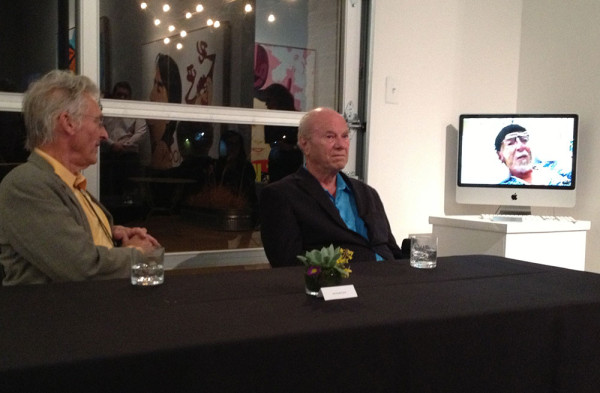
The room was still and uncomfortable. We were witnessing someone presumably at the end of his life. And we were also witnessing his two old friends, confronted with his frailty, containing their shock and sadness in this artificial public setting, in this little gallery, in this strange city. The normal motions of such a situation (panel—funny story—insightful observation) didn’t feel right. There was nothing for these guys to say. It was too late to talk about their friend’s work, and too early for eulogies.
The room was quiet.
And then, in the stillness, someone in the audience fainted.
Those of us sitting closer to the front heard a little commotion, and turned to see a few people huddled around a figure on the ground. Um—ah.
And even though the talk had barely gotten going, the curator/moderator said “I think we should end this now. I think we should end this now.” The man who had fainted recovered, and suddenly it was all over. Theo’s Skype was disconnected, Ruscha and Rosenquist stood up from the table, and the audience dispersed.
And it was the weirdest night I have ever spent in the Texas art scene, hands down.
As I sat there, trying to digest what had just happened, my gaze drifted over to Theo’s ROSENQUIST painting. I thought about how he knew so many of these “blue chip” artists. Throughout his life he had run with the best of the best, but whether from lack of ambition, bad luck, his own demons, or his artwork just not being at the same level, he had ended up without a star of the walk of art fame. Clearly, he was a powerful personality, a family man, adored by those who knew him. Why wasn’t he as famous as his two friends? Did he need money? Was he hoping that some of these paintings would sell? I thought about him undergoing treatment for cancer.
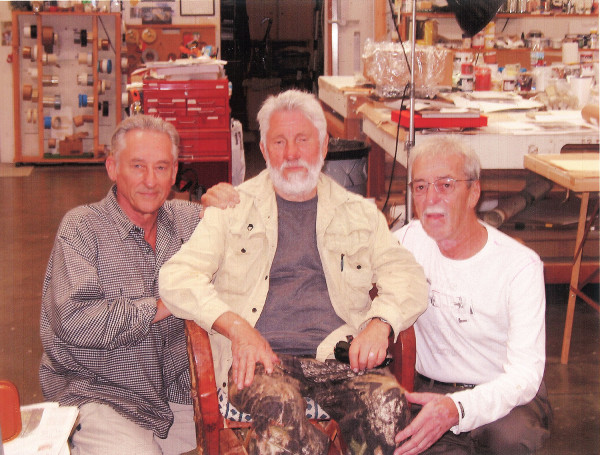
Anyone who has experienced the death of a loved one recognizes the intense, distilled clarity that comes in that moment, when all the unimportant things (meaning pretty much everything outside of the people we love), fall away. And in the bizarre intersection of art world fame and insignificance that was this evening, I realized that I had been the craven starfucker, traveling to see two famous artists without regard to the point of the event, and assuming I’d visit with the movers and shakers of the Dallas art scene. I was the one with the unseemly ironic reserve. I was the one wading around in stupid, cruel art world bullshit.
In the moment when Theo Wujcik, the great technical printmaker and beloved personality, laid his head on his hospital pillow, none of it mattered: not Rosenquist’s or Ruscha’s fame, or Theo’s lack thereof, or his late-career paintings, or the Dallas art scene, or the fainting guy in the audience, or me. What mattered was that brief, clean, quiet moment when Theo went silent and everyone in the room held our breaths. We were all in this together.
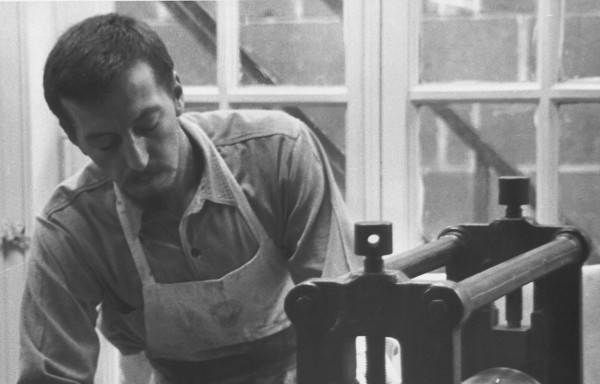
In memory of Theo Wujcik, January 29, 1936 – March 29, 2014.
Special thanks to Stanton Storer and Susan Johnson for their help with sourcing photographs.
Rainey Knudson is the founder and publisher of Glasstire.
3/8/14 Correction: The original version of this article incorrectly reported that the paintings in the show “Blue Chip” were executed in China.


